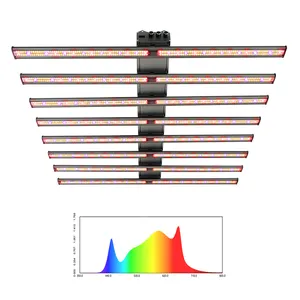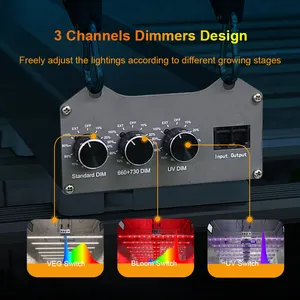(8421 products available)










































































































































































































UVB lights are artificial lights that emit UVB rays. They are used in different applications, such as tanning, horticulture, and health. UVB lights come in different types depending on the application. They include:
Tanning Lamps
Tanning lamps are UVB lights used in tanning beds. They are designed to stimulate melanin production in the skin. Tanning lamps are classified into two types. The first type is low-pressure UVB lamps. They are characterized by even tanning and lower risk of burns. The lamps produce a high amount of Vitamin D and have a shorter exposure time. The second type is high-pressure UVB lamps. They produce a high amount of UVA and have a higher intensity. The lamps have a lower amount of Vitamin D and a longer exposure time.
Reptile Lights
These are UVB lights designed for use with reptiles. They provide UVB rays that are important for reptiles' health. Reptile lights come in different forms. There are fluorescent bulbs that produce low to moderate UVB levels. They are characterized by energy efficiency. There are mercury vapor bulbs that produce high levels of UVB. They provide heat similar to the natural sunlight. There are also coil or spiral bulbs. They are characterized by high UVB output and directional options.
Medical Lamps
Medical UVB lamps are designed for use in dermatology. They are used for the treatment of skin conditions like psoriasis. Medical UVB lamps come in different types. There are narrowband UVB lamps. They are characterized by high effectiveness in treating skin conditions. They have minimal side effects. There are broadband UVB lamps. They are effective in the treatment of skin conditions. However, they have more side effects than narrowband UVB lamps.
Horticultural Lights
These UVB lights are used for plant growth. They stimulate the production of cannabinoids and terpenes in plants. Horticultural UVB lights include fluorescent lights, metal halide lights, and LED lights.
Vitamin D Lamps
These UVB lamps are used in health settings. They are designed to help people with Vitamin D deficiency. They are characterized by low risk of skin burning.
UVB lights are used for a variety of functions. They are used for therapeutic purposes, and in horticulture among other functions. The features discussed below highlight how the lights function in the different areas they are used.
Vitamin D Synthesis
UVB radiation is essential in vitamin D synthesis. When the skin is exposed to UVB rays, a chemical reaction occurs. 7-dehydrocholesterol is converted to vitamin D3. This is a very important process because vitamin D is important for calcium absorption. It also promotes bone health. UVB lamps are used in dermatology to provide vitamin D supplements to patients who need it.
Therapeutic Effects
UVB lights are used in phototherapy. These lights are applied to the skin using different devices. They are effective in treating skin disorders such as psoriasis and eczema. During treatment, the UVB light is directed to the affected skin areas. The light reduces inflammation and slows down the excessive skin cell growth. Phototherapy is a common treatment in dermatology.
Controlled Exposure
UVB lights are used in phototherapy to provide controlled exposure to UVB radiation. The exposure is controlled using specialized lamps. This ensures that the radiation is directed to the affected skin areas without harming the surrounding skin. The lamps produce a specific wavelength of UVB radiation. This makes them safe for therapeutic use.
Reptile Basking
UVB lights are also used in reptile husbandry. These lights are placed in habitats to imitate natural sunlight. When reptiles bask under the lights, they absorb the UVB radiation. This helps in vitamin D synthesis. The lights are important because they help reptiles maintain healthy bones and metabolic functions.
Horticultural Applications
UVB lights are also used in plants cultivation. The lights are placed in controlled growing environments such as greenhouses. They help in stimulating secondary metabolites production in plants. These metabolites are important in plants' immune response. They help in reducing the risk of diseases and pests. UVB radiation is also important in enhancing flavors and antioxidants in fruits and flowers.
UVB lights have various applications across different industries and fields. Here are some common scenarios where UVB lights are used:
Tanning Salons
UVB lights are used in tanning beds to simulate the sun's natural tanning process. The UVB rays stimulate melanin production in the skin, leading to a tan. Tanning salons use UVB lights in different configurations, such as dominant UVB or balanced UVB/UVA, to cater to various skin types and tanning preferences.
Dermatology Clinics
UVB lights are used in dermatology clinics for phototherapy treatments. Controlled exposure to UVB rays helps treat various skin conditions like psoriasis, eczema, and vitiligo. Dermatologists use specialized UVB lamps or narrowband UVB systems to deliver targeted and effective treatments.
Reptile Habitats
UVB lights are used in reptile enclosures to mimic natural sunlight. The UVB rays enable reptiles to synthesize vitamin D3, which is essential for calcium metabolism and bone health. Pet owners and zoological institutions use UVB lights to ensure the health and well-being of reptiles in captivity.
Plant Growth
Some horticulturists use UVB lights to promote certain beneficial compounds in plants. Controlled exposure to UVB rays can enhance the production of secondary metabolites like flavonoids and anthocyanins in various crops. These compounds contribute to the color, flavor, and nutritional value of plants.
Vitamin D Synthesis
UVB lights are used in health and wellness centers to promote vitamin D synthesis in the skin. Artificial UVB sources provide a convenient way to enhance vitamin D levels, especially in regions with limited sunlight. UVB lights help prevent vitamin D deficiency and its associated health risks.
Cosmetic Industry
Some cosmetic products may incorporate UVB light filters to protect the skin from the harmful effects of UVB rays. These products aim to prevent sunburn and premature aging caused by UVB exposure. However, it is essential to note that not all cosmetic products offer complete sun protection, so additional sunscreen may be necessary.
Photography and Forensics
UVB lights are used in forensic labs to detect and analyze biological evidence. UVB rays cause certain bodily fluids, like blood and semen, to fluoresce, making them visible for crime scene investigations. Additionally, UVB lights are used in photography to reveal hidden details or patterns in artworks and documents.
Consider the following factors when choosing a UVB lamp for sale:
Type of UVB light
Each UV light has unique features that make it better suited for particular applications. Choose a lamp based on the intended use.
Wavelength
Different UVB wavelengths have unique biological effects. For instance, 280-320nm is ideal for vitamin D3 synthesis, while 320-340nm is safer and non-burning. Choose a lamp that provides the correct wavelength depending on the application.
Intensity and exposure duration
Consider the UVB light intensity and recommended exposure duration. Higher intensity lights require shorter exposure periods. Determine the appropriate balance to prevent adverse effects and achieve the desired benefits.
Safety features
Safety features minimize the adverse effects of UVB lights. Look for lights with built-in timers, cooling fans, and protective filters.
Energy efficiency and bulb lifespan
Choose UVB lights with high energy efficiency. Consider the bulb's lifespan and the replacement costs. A UVB light with a longer lifespan and high energy efficiency has low maintenance costs.
Portability and design
Some UVB lights are portable and feature adjustable stands. This design makes it easy to direct the UVB rays where needed. Consider such lights if planning to move them around.
Reviews and brand reputation
Read reviews and feedback from users to get insight into the light's performance and reliability. Consider the brand's reputation and choose a well-established brand that meets the quality standards.
Compliance and certification
Choose a UVB light that complies with the safety regulations. It should have the necessary certifications.
Q1. Do UVB lights cause sunburn?
A1. Yes, UVB lights can cause sunburn. These lights emit UVB rays, which are known to cause skin burns. However, UVB lights are also used to treat skin conditions in controlled environments. When used in tanning beds or therapy lamps, the exposure time and intensity are controlled to prevent sunburn.
Q2. How long should one stay under UVB lights?
A2. The duration one should stay under UVB lights depends on their purpose. For tanning, the duration varies based on skin type. For therapeutic purposes, the duration is determined by the dermatologist based on the skin condition and the UVB light intensity. It’s important to follow recommended guidelines to prevent overexposure.
Q3. Are all UVB lights the same?
A3. No, not all UVB lights are the same. Different UVB lights have varying wavelengths, and intensity and they are designed for different purposes. Some lights, like UVB tanning lamps, are meant for tanning, while others, like therapeutic UVB lamps, are used for treating specific skin conditions.
Q4. Can UVB lights be used without a dermatologist?
A4. UVB lights can be used without a dermatologist for purposes like tanning. However, it’s important to know they can cause skin burns if not used properly. Therefore, it’s advisable to consult a dermatologist for therapeutic use to get guidance on safe usage and avoid overexposure.